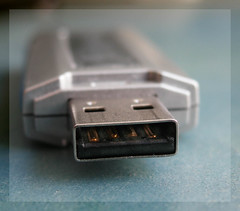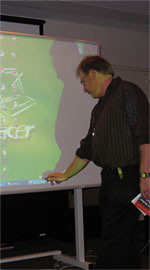The way I plan for my teaching has changed a lot over the past few years. This really was obvious today as my wife, Joanne, planned for her two days of teaching this week in the manner that I did not so long ago - writing out lesson plans by hand, cross referencing her resource books and creating some resources by jumping on the family desktop and printing it off ready for the photocopier. To be fair, she is just returning to teaching this year after five or so years out of the classroom (and we all know that the world has changed just a tad in that time) and she is teaching five-year-olds while I'm at the other end of the primary school spectrum. So, I thought I'd take ten minutes now and detail how planning digitally grants me flexibility and opportunity that was not possible in the past.
Firstly, I have the luxury of a school laptop. This means I can operate wirelessly wherever I feel comfortable around the house. I construct my program on a private wiki shared with my tandem partner and co-planning buddy - this enables transparency, collaboration, pooled resources and consistency in what we deliver in the classroom. We share documents, URL's and flipcharts via this wiki. I have all of my key documents on my hard drive and backed up on my 8GB thumbdrive. So, if I want to check if I have the laptops booked for my Literacy session on Monday, I can pull that document up in seconds. Likewise, if I want to see if there is a spare slot to take my class to the Resource Centre, I can also have that for checking in an instant.
Our Inquiry Scope and Sequence document is readily available, as are my PDF versions of SACSA, our mandated curriculum. So today, I quickly checked what the next inquiry unit was, briefly read the relevant outcomes from the SACSA Lite PDF and did a quick search on YouTube to see if I could find anything that suited the theme of human effects on the planet which is the broad concept behind the title of "Whose Fault Is It?" The YouTube search found a clip from a CNN documentary titled "Planet In Peril" which gave me a new lead to follow.
I found the website, and the Google Video version, which I know won't cope with our school filter and internet speed at school, so in the spirit of educational purpose, I started Vuze on the main desktop and started to download a torrent of the documentary so I could show excerpts tomorrow on the interactive whiteboard. This doco would be an ideal resource for "frontloading" students with ideas, base knowledge and questions for their own independent research later in the term. I also mentally noted the RSS feeds on the original website and fired off an e-mail to my colleagues about this find and then saved it to my delicious account.
I've been reading Dan Meyer's blog - in particular his refit of a Darren Kuropatwa mathematics lesson - and with this in mind started planning one of my own on the concept of measurement in metres. Another concept that needs to be covered is scale drawing, so I used Google Maps to get a decent screengrab of the school for a introductory lesson based on the BER intiative. I dumped this into a flipchart for the IWB and into a worksheet that could be given out to the students. With this image safely stowed, I posed the problem that will logically require some conceptual measurement skills and then headed over to the DECS website to download plans for new libraries and classroom blocks which I'm hoping someone tomorrow is going to point out as a requirement to successfully meet the assigned challenge.
With all of these plans detailed on the wiki and saved, I decided to write this post. Time now for some tortilla wraps for the family evening meal, then back after tea to insert some links here and then to assess last term's final inquiry assessment tasks which are sitting waiting for me on my students' blogs. If I don't get distracted doing other things, that is.





 I've been hosting a few visitors again and it's the interactive whiteboards that seem to be the main attraction. I had a team from a local educational publishing company sit in on one of my lessons to see one in action and gain some ideas about how to design content (books, digital resources, support materials) that fits with a classroom that is moving more into the digital world. Amazingly, one of the graphic designers was an ex-student of mine from my teaching days in Port Augusta (in my Year 3/4 class back in 1992) - feeling old at 41!
I've been hosting a few visitors again and it's the interactive whiteboards that seem to be the main attraction. I had a team from a local educational publishing company sit in on one of my lessons to see one in action and gain some ideas about how to design content (books, digital resources, support materials) that fits with a classroom that is moving more into the digital world. Amazingly, one of the graphic designers was an ex-student of mine from my teaching days in Port Augusta (in my Year 3/4 class back in 1992) - feeling old at 41! Then tonight, I took a group (of which I am a member) from my son's school's Governing Council around my school to get some ideas around the theme of Assets Improvement. This group are parents from other non-education areas of the workforce and they really wanted to see an IWB in action for the first time. I know that the "wow" factor is always more pronounced with adults but I did point out that nearly everything I produce now in the course of my work is digital. I do my programming on a wiki (easier to embed the web links I like to use), I create flipcharts to introduce concepts and take students through units of work, my school communication runs on email and the electronic daybook and I produce document after document in the course of my daily work. Then in the evening, I network with my global colleagues, hunt down and tag potential online resources and read widely varying big and small picture perspectives on technology, education and the space between the two.
Then tonight, I took a group (of which I am a member) from my son's school's Governing Council around my school to get some ideas around the theme of Assets Improvement. This group are parents from other non-education areas of the workforce and they really wanted to see an IWB in action for the first time. I know that the "wow" factor is always more pronounced with adults but I did point out that nearly everything I produce now in the course of my work is digital. I do my programming on a wiki (easier to embed the web links I like to use), I create flipcharts to introduce concepts and take students through units of work, my school communication runs on email and the electronic daybook and I produce document after document in the course of my daily work. Then in the evening, I network with my global colleagues, hunt down and tag potential online resources and read widely varying big and small picture perspectives on technology, education and the space between the two.



